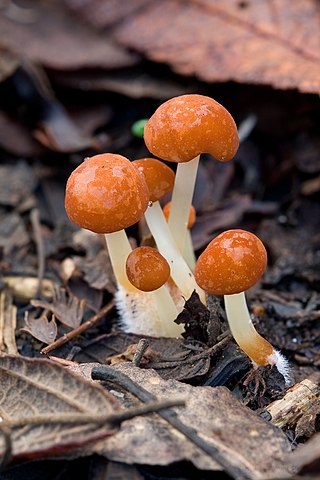
Marasmius is a genus of mushroom-forming fungi in the family Marasmiaceae. It contains about 500 species of agarics, of which a few, such as Marasmius oreades, are edible. However, most members of this genus are small, unimpressive brown mushrooms. Their humble appearance contributes to their not being readily distinguishable to non-specialists, and they are therefore seldom collected by mushroom hunters. Several of the species are known to grow in the characteristic fairy ring pattern.
In biological nomenclature, a nomen novum, new replacement name is a scientific name that is created specifically to replace another scientific name, but only when this other name cannot be used for technical, nomenclatural reasons. It does not apply when a name is changed for taxonomic reasons. It is frequently abbreviated, e.g.nomen nov., nom. nov..
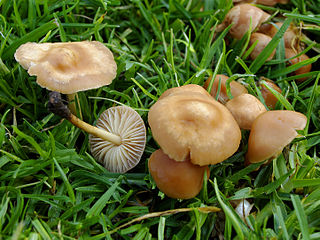
Marasmius oreades, also known as the fairy ring mushroom, fairy ring champignon or Scotch bonnet, is a mushroom native to North America and Europe. Its common names can cause some confusion, as many other mushrooms grow in fairy rings, such as the edible Agaricus campestris and the poisonous Chlorophyllum molybdites.

Collybia is a genus of mushrooms in the family Tricholomataceae. The genus has a widespread but rare distribution in northern temperate areas, and contains three species that grow on the decomposing remains of other mushrooms.

Mycetinis is a genus of fungus in the Omphalotaceae family, containing about eight species formerly classified in Marasmius.

Marasmius elegans, commonly known as the velvet parachute, is a species of fungus in the family Marasmiaceae. It has a reddish-brown cap, and a whitish stipe with white hairs at the base. It can be found in eucalypt forests in Australia.

Marasmius rotula is a common species of agaric fungus in the family Marasmiaceae. Widespread in the Northern Hemisphere, it is commonly known variously as the pinwheel mushroom, the pinwheel marasmius, the little wheel, the collared parachute, or the horse hair fungus. The type species of the genus Marasmius, M. rotula was first described scientifically in 1772 by mycologist Giovanni Antonio Scopoli and assigned its current name in 1838 by Elias Fries.

Marasmius sasicola is a species of Marasmiaceae fungus known from Kanagawa Prefecture, Japan. First collected in 2000, it was described in 2002 by Haruki Takahashi. The species produces small mushrooms with white caps and very short, very thin black stems. Unlike in other, similar species, the stems enter the plant matter on which the mushroom grows. The six to eight white gills are spread out around the cap, and all of them reach the stem. The flesh has no taste or odour. Found in June, the species grows on dead Sasa leaves, from which it takes its specific epithet.

Marasmius funalis is a species of Marasmiaceae fungus known only from Japan. The species produces small mushrooms with reddish-brown caps up to 6 millimetres (0.24 in) in diameter and dark-brown, threadlike stems of up to 50 millimetres (2.0 in) in length. The species has a number of distinctive microscopic features, including very long cystidia on the stem, visible as bristles. Described in 2002 by Haruki Takahashi, the species grows on dead wood. The closest relative of M. funalis is M. liquidambari, known from Mexico and Papua New Guinea, and it is also similar in appearance to M. hudonii and Setulipes funaliformis, the latter of which was named after M. funalis.
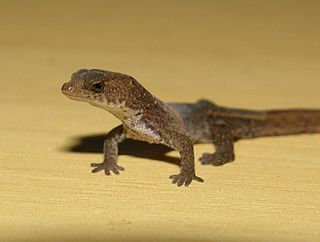
The Brazilian pygmy gecko is a species of South American lizard in the family Sphaerodactylidae. The species is monotypic in the genus Chatogekko. It grows to a maximum total length of only 24 millimetres (0.94 in). It is found in leaf litter on the forest floor, and preys on springtails and mites. The species is oviparous.
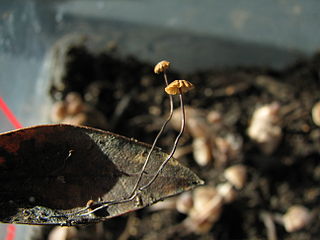
Cryptomarasmius is a genus of fungi in the family Physalacriaceae.
Marasmius midnapurensis is a species of agaric fungus in the family Marasmiaceae that was first described scientifically in 2014. It is known only from its type locality, in the Midnapur district of West Bengal (India), where it grows on the dried leaves and wood of Acacia. Phylogenetic analysis of the internal transcribed spacer DNA suggests that the fungus is a species distinct from close relatives such as M. jasminodorus and M. aurantioferrugineus, and that it should be classified in Marasmius section Sicci.
Marasmius aporpus is a species of fungus in the large agaric genus Marasmius. Found in Chile, it was described as new to science in 1969 by mycologist Rolf Singer.
Marasmius austrorotula is a species of fungus in the large agaric genus Marasmius. Found in Argentina, where it grows on the fallen leaves of South American mountain bamboos, it was described as new to science in 1969 by mycologist Rolf Singer.
Marasmius valdivianus is a species of fungus in the large agaric genus Marasmius. Found in Chile, the fungus was described as new to science in 1969 by mycologist Rolf Singer.
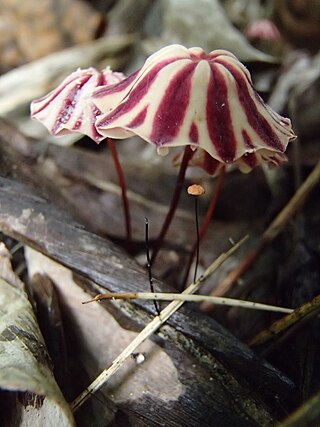
Marasmius tageticolor is a species of agaric fungus in the family Marasmiaceae. Its fruit bodies have striped red and white caps. It is found in Mexico, Central America, and South America, where it grows on twigs.

Rhizomarasmius setosus is a tiny whitish mushroom having a distinctive hairy stem. It has been given the vernacular name "Beechleaf Parachute".
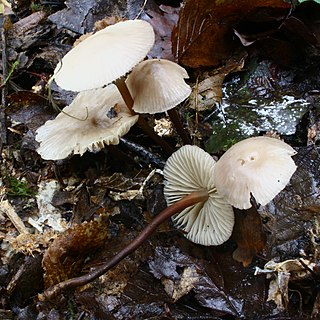
Marasmius wynneae is a species of gilled mushroom found in European woods.












